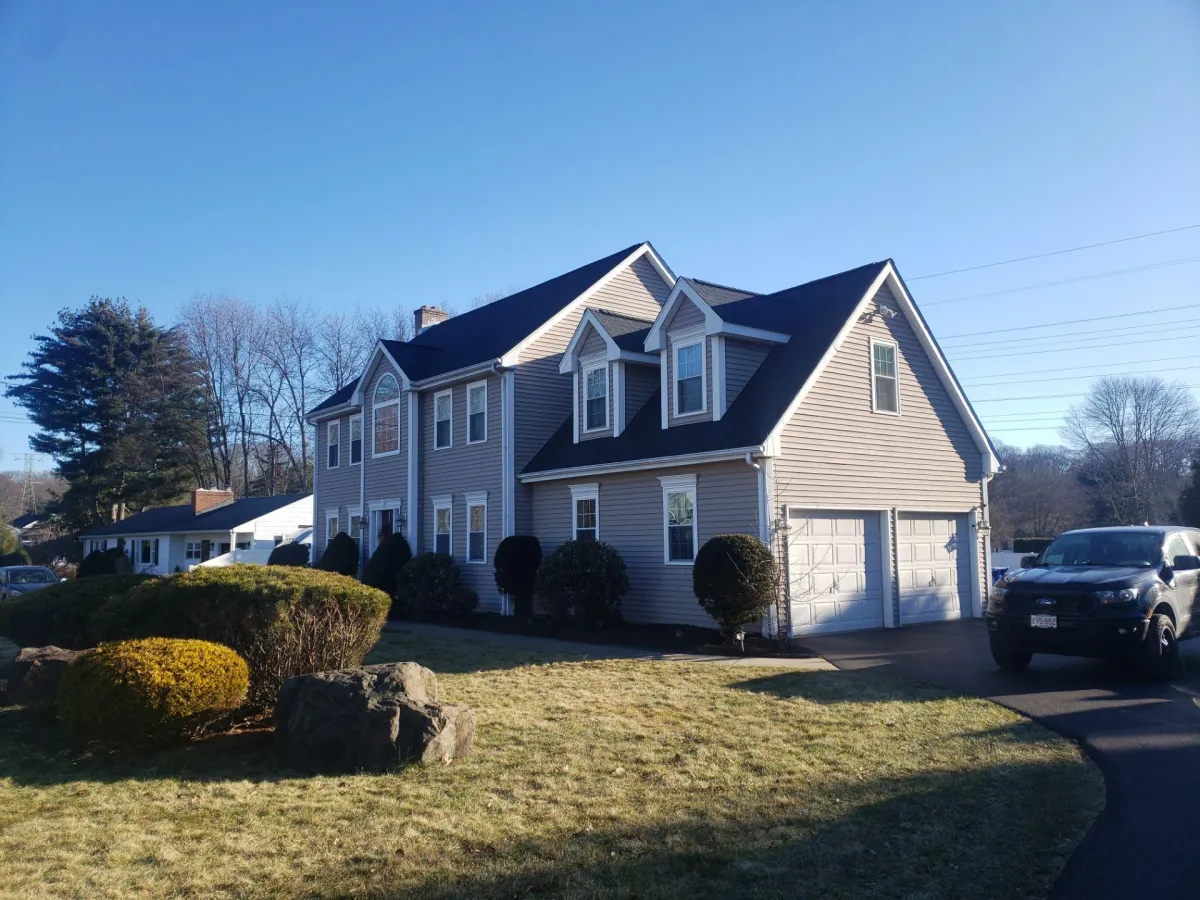LEARNING CENTER

Common Siding Repair Issues and How to Address Them
As a homeowner, the exterior of your house is the first thing visitors see, and the condition of your siding plays a crucial role in your home's overall curb appeal and protection. Siding is designed to shield your home from the elements, but over time, it can succumb to various types of damage that require prompt siding repair. In this comprehensive guide, we'll explore the most common siding repair issues and provide you with the knowledge and tools to address them effectively.
Understanding Siding Damage
Siding is exposed to a wide range of environmental stressors, from harsh weather conditions to pest infestations. These factors can lead to a variety of siding repair issues, each with its own set of symptoms and solutions. By familiarizing yourself with the most prevalent siding problems, you can be better equipped to identify and address them before they escalate into major headaches.
Cracked or Warped Siding
One of the most common siding repair issues is the occurrence of cracks or warping in the material. This can be caused by a variety of factors, including exposure to extreme temperatures, structural movement, or even poor initial installation. Cracked or warped siding not only detracts from the visual appeal of your home but can also compromise the integrity of the entire siding system, leading to further siding damage and potential water intrusion.
To address this siding repair issue, it's essential to identify the underlying cause of the problem. If the siding damage is localized, a simple siding repair using a specialized sealant or patch may be sufficient. However, if the issue is more widespread or the result of a larger structural problem, it may be necessary to replace the affected siding panels or even consider a full siding replacement.
Peeling or Fading Paint
Another common siding repair concern is peeling or fading paint. This can be caused by a variety of factors, including exposure to UV radiation, moisture, or poor paint application during the initial installation. Peeling or fading paint not only detracts from the aesthetic appeal of your home but can also lead to further siding damage if left unaddressed.
To address this siding repair issue, it's important to first identify the root cause of the problem. If the paint is simply fading due to UV exposure, a fresh coat of high-quality, UV-resistant paint may be sufficient. However, if the issue is caused by moisture intrusion or poor paint application, it may be necessary to remove the existing paint, repair any underlying siding damage, and apply a new, high-quality paint system.
Mold and Mildew Growth
Siding can also be susceptible to mold and mildew growth, particularly in damp or humid environments. This can be a serious siding repair issue, as mold and mildew can not only compromise the structural integrity of the siding but also pose health risks to the occupants of the home.
To address this problem, it's important to first identify and address the underlying cause of the moisture that is allowing the mold and mildew to thrive. This may involve sealing any cracks or gaps in the siding, improving ventilation, or addressing other sources of moisture. Once the root cause has been addressed, the affected siding can be cleaned using a specialized mold and mildew removal solution, and the area can be treated with a fungicide to prevent future growth.
Insect Damage
Siding can also be vulnerable to damage from various types of insects, such as woodpeckers, termites, or carpenter ants. This type of siding damage can compromise the structural integrity of the siding and lead to further issues, such as water intrusion or even structural instability.
To address insect-related siding repair issues, it's important to first identify the specific type of insect causing the problem and then take appropriate action to eliminate the infestation. This may involve the use of specialized pest control treatments or the replacement of the affected siding panels. It's also important to take preventative measures, such as regular inspections and maintaining the overall health of the siding, to reduce the risk of future insect-related siding damage.
Hail or Impact Damage
Severe weather events, such as hailstorms or high winds, can also cause significant siding damage. This type of siding damage can manifest in the form of dents, cracks, or even complete panel failure, leaving your home vulnerable to water intrusion and other issues.
To address hail or impact-related siding repair issues, it's important to carefully inspect the affected area and determine the extent of the damage. In some cases, minor dents or cracks may be repairable using specialized siding repair techniques. However, in more severe cases, it may be necessary to replace the affected siding panels to restore the integrity and appearance of your home's exterior.
Proper Siding Maintenance
In addition to addressing specific siding repair issues, it's also essential to establish a regular siding maintenance routine to help prevent and mitigate future problems. This can include:
1. Regular Inspections: Conduct a thorough inspection of your home's siding at least once a year, looking for signs of siding damage, wear, or potential issues. This can help you identify problems early on and address them before they escalate.
2. Cleaning and Maintenance: Regularly clean your siding using a gentle, non-abrasive cleaner to remove dirt, debris, and any signs of mold or mildew. This can help extend the life of your siding and maintain its appearance.
3. Caulking and Sealing: Check for any gaps or cracks in the siding and use a high-quality caulk or sealant to fill them, preventing moisture intrusion and further siding damage.
4. Painting or Staining: If your siding is painted or stained, be sure to maintain the finish by reapplying it as needed, typically every 5-10 years, depending on the material and climate.
5. Prompt Siding Repair: If you do notice any siding damage, address it promptly to prevent it from worsening and leading to more extensive (and expensive) repairs.
By following these siding maintenance best practices, you can help protect your home's exterior and reduce the likelihood of having to deal with costly siding repair issues in the future.
Identifying and Addressing Siding Repair Issues
Now that we've covered the most common siding repair issues and the importance of proper maintenance, let's dive into the specifics of how to identify and address these problems effectively.
Cracked or Warped Siding Repair
As mentioned earlier, cracked or warped siding can be caused by a variety of factors, including exposure to extreme temperatures, structural movement, or poor initial installation. To address this siding repair issue, follow these steps:
1. Inspect the affected area: Carefully examine the cracked or warped siding to determine the extent of the siding damage and identify the underlying cause.
2. Clean the area: Use a soft-bristled brush and a mild detergent to clean the affected area, removing any dirt, debris, or loose material.
3. Repair small cracks or warping: For minor cracks or warping, you can use a specialized siding repair compound or epoxy to fill and smooth the affected area. Be sure to follow the manufacturer's instructions carefully.
4. Replace severely damaged panels: If the siding is severely cracked or warped, it may be necessary to replace the affected panels. Carefully remove the damaged pieces and install new siding panels, ensuring a proper fit and seal.
5. Address the root cause: Once the visible siding damage has been addressed, it's important to identify and address the underlying cause of the problem, such as structural movement or improper installation, to prevent future siding repair issues.
Peeling or Fading Paint Repair
Peeling or fading paint can be a frustrating siding repair issue, but with the right approach, it can be addressed effectively. Here's how:
1. Prepare the surface: Begin by thoroughly cleaning the affected area, removing any loose or flaking paint with a scraper or wire brush.
2. Sand the area: Use fine-grit sandpaper to smooth the surface and create a clean, even base for the new paint.
3. Prime the area: Apply a high-quality primer to the sanded surface, ensuring it adheres properly and seals any exposed siding material.
4. Apply new paint: Once the primer has dried, apply a fresh coat of high-quality, UV-resistant paint, following the manufacturer's instructions for application and drying time.
5. Maintain the paint: Regularly inspect the painted siding and touch up any areas that begin to show signs of wear or fading to keep your home's exterior looking its best.
Mold and Mildew Removal
Mold and mildew growth on siding can be a serious siding repair issue, both aesthetically and from a health perspective. To address this problem, follow these steps:
1. Identify and address the root cause: Determine the source of the moisture that's allowing the mold and mildew to thrive, and take steps to resolve the underlying issue.
2. Clean the affected area: Use a specialized mold and mildew removal solution to clean the affected siding, following the product's instructions carefully.
3. Treat with a fungicide: Apply a fungicide to the cleaned area to kill any remaining mold or mildew spores and prevent future growth.
4. Monitor and maintain: Regularly inspect the siding for any signs of recurring mold or mildew and address them promptly to prevent the problem from resurfacing.
Insect Damage Repair
Insect-related siding damage can be a complex siding repair issue, as it often requires both structural repairs and pest control measures. Here's how to approach it:
1. Identify the pest: Carefully inspect the affected area to determine the type of insect causing the siding damage, as this will inform the appropriate treatment strategy.
2. Eliminate the infestation: Depending on the type of insect, you may need to employ specialized pest control methods, such as fumigation or the use of insecticides, to eliminate the infestation.
3. Repair the damaged siding: Once the pest issue has been addressed, replace any severely damaged siding panels and use sealants or other repair techniques to address any minor siding damage.
4. Implement preventative measures: Consider installing physical barriers, such as insect screens or siding with built-in insect resistance, to deter future infestations.
Hail or Impact Damage Repair
Repairing siding that has been damaged by hail or other impact events can be a more complex siding repair process, but it's essential to address the problem promptly to prevent further issues. Here's how to approach it:
1. Assess the damage: Carefully inspect the affected siding to determine the extent of the damage, including any dents, cracks, or panel failures.
2. Document the damage: Take detailed photographs of the affected areas and document the siding damage, as this information may be necessary for insurance claims or warranty purposes.
3. Repair minor damage: For small dents or cracks, you may be able to use specialized siding repair techniques, such as dent removal tools or sealants, to restore the affected area.
4. Replace severely damaged panels: If the siding has suffered more extensive damage, such as panel failures or large cracks, it may be necessary to replace the affected panels to restore the integrity and appearance of your home's exterior.
5. Protect against future damage: Consider upgrading to impact-resistant siding materials or installing protective features, such as storm shutters or siding guards, to reduce the risk of future siding damage.
The Importance of Proper Siding Repair
Addressing siding repair issues in a timely and effective manner is crucial for several reasons:
1. Preserving your home's value: Well-maintained siding not only enhances your home's curb appeal but also helps to preserve its overall value. Neglecting siding repairs can lead to further siding damage and a decline in your property's worth.
2. Protecting your home's structural integrity: Siding plays a critical role in shielding your home from the elements, including water, wind, and extreme temperatures. Unaddressed siding damage can compromise this protection, leading to water intrusion, structural problems, and even safety hazards.
3. Improving energy efficiency: Properly maintained siding can also contribute to your home's energy efficiency, helping to regulate indoor temperatures and reduce your utility bills. Conversely, damaged or poorly insulated siding can lead to increased energy consumption and higher costs.
4. Maintaining your home's appearance: The condition of your siding is a significant factor in your home's overall aesthetic appeal. Neglecting siding repairs can result in an unsightly and unkempt appearance, detracting from your home's curb appeal and potentially impacting the neighborhood's property values.
5. Avoiding costly future repairs: Addressing siding repair issues promptly and thoroughly can help you avoid more extensive and costly repairs down the line. Delaying siding repairs can often lead to compounded siding damage and the need for more extensive (and expensive) remediation.
By understanding the common siding repair issues, implementing proper maintenance practices, and addressing problems in a timely manner, you can ensure your home's exterior remains in top condition, protecting your investment and enhancing your property's value and appeal.
Conclusion
Siding repair is an essential aspect of home maintenance, and addressing issues promptly and effectively is crucial for preserving your home's structural integrity, energy efficiency, and overall aesthetic appeal. From cracked or warped siding to mold and mildew growth, a wide range of siding repair issues can arise, each requiring a specific approach to address the problem and its underlying causes.
By familiarizing yourself with the most common siding repair issues and following the step-by-step guides provided in this article, you can take proactive steps to maintain your home's exterior and avoid costly future repairs. Remember, regular inspections, prompt siding repair, and a commitment to proper siding maintenance are the keys to keeping your home's siding in top condition.
If you're unsure about how to tackle a particular siding repair issue or require professional assistance, don't hesitate to consult with a reputable siding contractor. They can help you identify the problem, recommend the best course of action, and ensure the siding repairs are completed to the highest standards, protecting your home and preserving its value for years to come.
Follow Us!
© 2023 TJR Construction LLC All Rights Reserved. | Powererd by 99 Creatives
Privacy Policy




